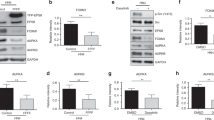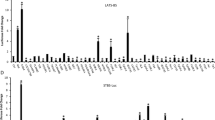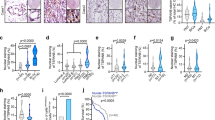Abstract
SHP-2 is a ubiquitously expressed non-transmembrane tyrosine phosphatase with two SH2 domains. Multiple reverse-genetic studies have indicated that SHP-2 is a required component for organ and animal development. SHP-2 wild-type and homozygous mutant mouse fibroblast cells in which the N-terminal SH2 domain was target-deleted were used to examine the function of SHP-2 in regulating Phosphatidylinositol 3-Kinase (PI3K) activation by growth factors. In addition, SHP-2 and various mutants were introduced into human glioblastoma cells as well as SHP-2−/− mouse fibroblasts. We found that EGF stimulation and EGFR oncoprotein (ΔEGFR) expression independently induced the co-immunoprecipitation of the p85 subunit of PI3K with SHP-2. Targeted deletion of the N-terminal SH2 domain of SHP-2 severely impaired PDGF- and IGF-induced Akt phosphorylation. Ectopic expression of SHP-2 in U87MG gliobastoma cells elevated EGF-induced Akt phosphorylation, and the effect was abolished by mutation of its N-terminal SH2 domain. Likewise, the reconstitution of SHP-2 expression in the SHP-2−/− cells enhanced Akt phosphorylation induced by EGF while rescuing that induced by PDGF and IGF. Further lipid kinase activity assays confirmed that SHP-2 modulation of Akt phosphorylation correlated with its regulation of PI3K activation. Based on these results, we conclude that SHP-2 is required for mediating PI3K/Akt activation, and the N-terminal SH2 domain is critically important for a ‘positive’ role of SHP-2 in regulating PI3K pathway activation.
This is a preview of subscription content, access via your institution
Access options
Subscribe to this journal
Receive 50 print issues and online access
$259.00 per year
only $5.18 per issue
Buy this article
- Purchase on Springer Link
- Instant access to full article PDF
Prices may be subject to local taxes which are calculated during checkout






Similar content being viewed by others
References
Alessi DR, Andjelkovic M, Caudwell B, Cron P, Morrice N, Cohen P, Hemmings BA . 1996 EMBO J. 15: 6541–6551
Allard JD, Chang HC, Herbst R, McNeill H, Simon MA . 1996 Development 122: 1137–1146
Bennett AM, Hausdorff SF, O'Reilly AM, Freeman RM, Neel BG . 1996 Mol. Cell. Biol. 16: 1189–1202
Carlberg K, Rohrschneider LR . 1997 J. Biol. Chem. 272: 15943–15950
Chen B, Bronson RT, Klaman LD, Hampton TG, Wang JF, Green PJ, Magnuson T, Douglas PS, Morgan JP, Neel BG . 2000 Nat. Genet. 24: 296–299
Craddock BL, Welham MJ . 1997 J. Biol. Chem. 272: 29281–29289
Cuevas B, Lu Y, Watt S, Kumar R, Zhang J, Siminovitch KA, Mills GB . 1999 J. Biol. Chem. 274: 27583–27589
Deb TB, Wong L, Salomon DS, Zhou G, Dixon JE, Gutkind JS, Thompson SA, Johnson GR . 1998 J. Biol. Chem. 273: 16643–16646
Feng GS, Hui CC, Pawson T . 1993 Science 259: 1607–1611
Feng GS, Pawson T . 1994 Trends Genet. 10: 54–58
Feng GS . 1999 Exp. Cell. Res. 253: 47–54
Fixman ED, Holgado-Madruga M, Nguyen L, Kamikura DM, Fournier TM, Wong AJ, Park M . 1997 J. Biol. Chem. 272: 20167–20172
Gesbert F, Guenzi C, Bertoglio J . 1998 J. Biol. Chem. 273: 18273–18281
Gu H, Pratt JC, Burakoff SJ, Neel BG . 1998 Mol. Cell 2: 729–740
Hakak Y, Hsu YS, Martin GS . 2000 Oncogene 19: 3164–3171
Hemmings BA . 1997 Science 275: 628–630
Holgado-Madruga M, Emlet DR, Moscatello DK, Godwin AK, Wong AJ . 1996 Nature 379: 560–564
Kharitonenkov A, Chen Z, Sures I, Wang H, Schilling J, Ullrich A . 1997 Nature 386: 181–186
Lechleider RJ, Freeman Jr RM, Neel BG . 1993 J. Biol. Chem. 268: 13434–13438
Manes S, Mira E, Gomez-Mouton C, Zhao ZJ, Lacalle RA, Martinez-A C . 1999 Mol. Cell. Biol. 19: 3125–3135
Moscatello DK, Holgado-Madruga M, Emlet DR, Montgomery RB, Wong AJ . 1998 J. Biol. Chem. 273: 200–206
Myers MP, Pass I, Batty IH, Van Der Kaay J, Stolarov JP, Hemmings BA, Wigler MH, Downes CP, Tonks NK . 1998 Proc. Natl. Acad. Sci. USA 95: 13513–13518
Nagane M, Levitzki A, Gazit A, Cavenee WK, Huang H-JS . 1998 Proc. Natl. Acad. Sci. USA 95: 5724–5729
Neel BG . 1993 Semin. Cell. Biol. 4: 419–432
Nishikawa R, Ji XD, Harmon RC, Lazar CS, Gill GN, Cavenee WK, Huang H-JS . 1994 Proc. Natl. Acad. Sci. USA 91: 7727–7731
Oh ES, Gu H, Saxton TM, Timms JF, Hausdorff S, Frevert EU, Kahn BB, Pawson T, Neel BG, Thomas SM . 1999 Mol. Cell. Biol. 19: 3205–3215
O'Reilly AM, Neel BG . 1998 Mol. Cell. Biol. 18: 161–177
O'Rourke DM, Qian X, Zhang H-T, Davis JG, Nute E, Meinkoth J, Greene MI . 1997 Proc. Natl. Acad. Sci. USA 94: 3250–3255
O'Rourke DM, Nute EJ, Davis JG, Wu C, Lee A, Murali R, Zhang HT, Qian X, Kao CC, Greene MI . 1998 Oncogene 16: 1197–1207
Qian X, O'Rourke DM, Fei Z, Zhang HT, Kao CC, Greene MI . 1999 J. Biol. Chem. 274: 574–583
Qu CK, Yu WM, Azzarelli B, Feng GS . 1999 Proc. Natl. Acad. Sci. USA 96: 8528–8533
Rodriguez-Viciana P, Warne PH, Khwaja A, Marte BM, Pappin D, Das P, Waterfield MD, Ridley A, Downward J . 1997 Cell. 89: 457–467
Saxton TM, Henkemeyer M, Gasca S, Shen R, Rossi DJ, Shalaby F, Feng GS, Pawson T . 1997 EMBO J. 16: 2352–2364
Shi ZQ, Lu W, Feng GS . 1998 J. Biol. Chem. 273: 4904–4908
Takahashi Y, Akanuma Y, Yazaki Y, Kadowaki T . 1999 J. Cell Physiol. 178: 69–75
Toker A, Cantley LC . 1997 Nature 387: 673–676
Vogel W, Lammers R, Huang J, Ullrich A . 1993 Science 259: 1611–1614
Wu CJ, Chen Z, Ullrich A, Greene MI, O'Rourke DM . 2000 Oncogene 19: 3999–4010
Yu DH, Qu CK, Henegariu O, Lu X, Feng GS . 1998 J. Biol. Chem. 273: 21125–21131
Acknowledgements
This work was supported by grants from the National Institute of Health and the Abramson Family Cancer Research Institute to MI Greene. This work was also supported by grants from the National Institutes of Health and the Department of Veteran Affairs to DM O'Rourke.
Author information
Authors and Affiliations
Corresponding author
Rights and permissions
About this article
Cite this article
Wu, CJ., O'Rourke, D., Feng, GS. et al. The tyrosine phosphatase SHP-2 is required for mediating phosphatidylinositol 3-kinase/Akt activation by growth factors. Oncogene 20, 6018–6025 (2001). https://doi.org/10.1038/sj.onc.1204699
Received:
Revised:
Accepted:
Published:
Issue Date:
DOI: https://doi.org/10.1038/sj.onc.1204699
Keywords
This article is cited by
-
Targeting SHP2 phosphatase in breast cancer overcomes RTK-mediated resistance to PI3K inhibitors
Breast Cancer Research (2022)
-
A comprehensive review of SHP2 and its role in cancer
Cellular Oncology (2022)
-
Discovery of a Novel Inhibitor of the Protein Tyrosine Phosphatase Shp2
Scientific Reports (2015)
-
Src kinases in chondrosarcoma chemoresistance and migration: dasatinib sensitises to doxorubicin in TP53 mutant cells
British Journal of Cancer (2013)
-
Protein tyrosine phosphatases in glioma biology
Acta Neuropathologica (2010)



